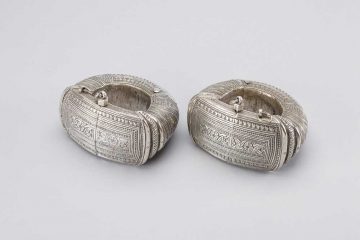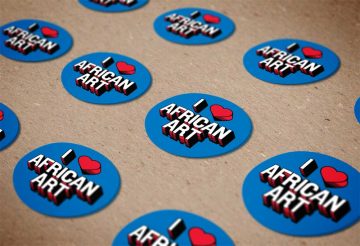

Witu, Lamu County, Kenya
Sandals, probably owned by Sultan Fumo Omari
c. 1890–94
Wood
Brooklyn Museum, Brooklyn Museum Collection, X1054a-b
Jewelry in Indian Ocean societies was considered a sound investment in one’s future and freedom and represented the financial security and autonomy of women. Individual pieces embodied memories and family histories and were treated as much-loved heirlooms. Women bequeathed their ornaments to female relatives or sold them in moments of hardship.
During the 19th and early 20th centuries, silversmiths in Swahili port towns enjoyed a swift business, with clients commissioning pieces that reflected international styles for occasions such as weddings, cultural events, and religious celebrations. Women of the Swahili Coast collected jewelry from afar, which intimately connected them to the seafaring cultures of the Indian Ocean world. Much of the jewelry on view can be seen in photographs of Swahili Coast women, whose sartorial flare brought Zanzibar fame, in European eyes, as the “Paris of East Africa.”

Omani artist
Oman
Disk necklace (sumt)
Early to mid-20th century
Silver, gold
Bait Al Zubair Museum, Muscat, Sultanate of Oman, 14.169
Attached on either side of the medallion are three Maria Theresa thalers. Originally minted in 1757 in Vienna, the Maria Theresa thaler was reminted on numerous occasions throughout the 19th and 20th centuries. The coin was popular in Indian Ocean trade for its silver content; it has been used as currency and as raw material to be melted down for jewelry and other luxury items. Similarly, jewelry was often melted and refashioned from one generation to the next to reflect the tastes of the current owners.

Swahili artist
Lamu, Lamu County, Kenya
Pair of wedding anklets
c. 19th to 20th century
Silver
Virginia Museum of Fine Arts, Robert and Nancy Nooter Collection, Adolph D. and Wilkins C. Williams Fund, 2003-19.1-2
Before modern banking, a family’s wealth on the Swahili Coast was typically invested in silver and gold jewelry. Silver was often preferred to gold—it was more affordable and allowed for larger, more elaborate pieces. Silver was also associated with talismanic power, or the ability to protect the wearer from other people’s envy or negative intentions.
